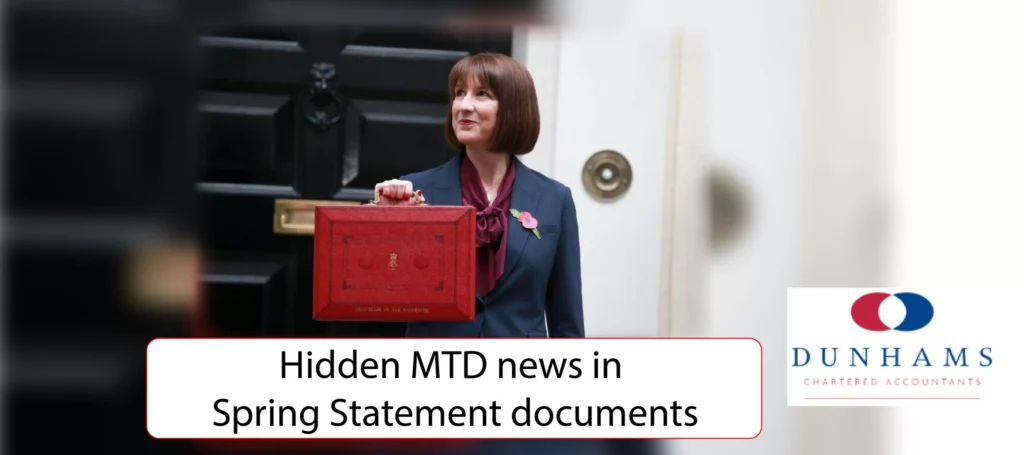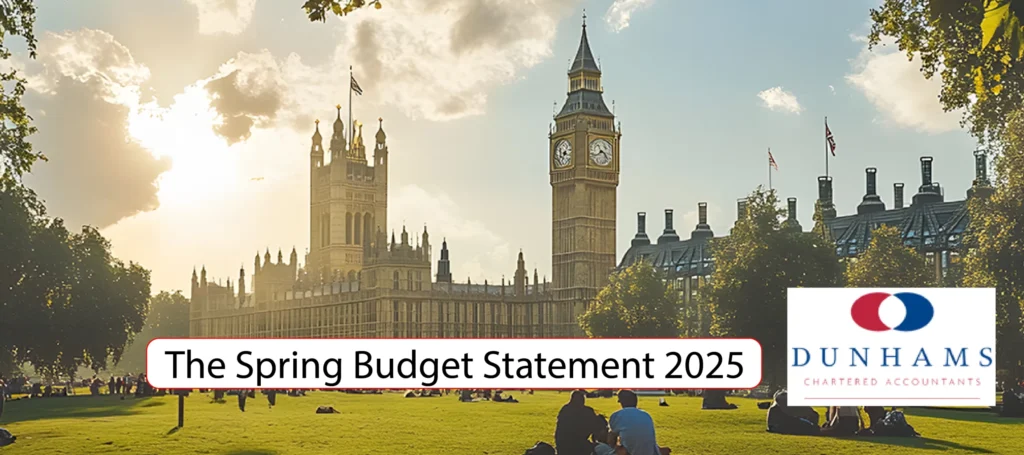Hidden MTD news in Spring Statement documents

Hidden MTD news in Spring Statement documents Chancellor Rachel Reeves kept her pledge that there would be no more tax rises at the Spring Statement, but there are some important Making Tax Digital developments hidden away in the tax related documents. What do you need to know? The timetable for Making Tax Digital for Income Tax Self-Assessment (MTD ITSA) includes mandating sole traders and landlords with revenue exceeding £50,000 from April 2026, then £30,000 the following year. The government has published a technical note alongside the Spring Statement documents that provide further details on the measures. The note includes the following key points: For more help with your Accounting need see our Services Page For Planning help see our Financial Page There is still no certainty of if and/or when taxpayers with income below £20,000 will be brought within MTD ITSA. The note simply says “As part of the ongoing rollout of MTD, the government will continue to explore how we can best bring the benefits of digitalisation to a greater proportion of the 4 million sole traders and landlords who have income below the £20,000 threshold.”
The Spring Statement 2025

The Spring Statement 2025 Chancellor of the Exchequer, Rachel Reeves, held the Spring Statement on Wednesday 26 March 2025. In the run up to the event, the Chancellor stated that she ‘remains committed to one major fiscal event a year to give families and businesses stability and certainty on upcoming tax and spending changes and, in turn, to support the government’s growth mission’. Table of contents. To see the Full Dunhams budget report download it here The Chancellor did meet her commitment that there would be no major tax announcements but tax is only one side of the equation. The other is spending and the Spring Statement confirmed a number of the measures recently announced, namely: There were also announcements about the rollout of the Making Tax Digital (MTD) for Income Tax project. Government spending announcements National security Reductions in the Official Development Assistance budget (overseas aid) will support an increase in NATO-qualifying defence spending to 2.5% of GDP by April 2027, with an ambition to increase to 3% in the next Parliament as economic and fiscal conditions allow. The Spring Statement accelerates towards this by providing an additional £2.2 billion of funding for the Ministry of Defence next year. Reform As announced by the Secretary of State for Work and Pensions, the government wants to create a more pro-work welfare system for those who can work and to protect those who cannot. These reforms are projected to save £4.8 billion from the welfare budget in 2029/30 and welfare spending will fall as a share of GDP in the medium term. This will include: The government is also looking for efficiencies from the state, including by bringing NHS England back into the Department of Health and Social Care. The Spring Statement announces a £3.25 billion Transformation Fund to drive efficiencies across government. Growth According to the government, growth is their central mission. The government will set out capital spending plans for the Parliament at the Spending Review in June. Ahead of that, the government has announced an additional £2 billion for social and affordable housing for 2026/27, as part of the government’s ambition to build 1.5 million homes in England in this Parliament, supported by reforms in the Planning and Infrastructure Bill. To ensure the construction industry has the capacity to deliver this government’s plan to get Britain building, the government has committed to a £625 million package for skills in construction, expected to provide up to 60,000 more skilled workers this Parliament. Personal Tax Tax bands and rates The basic rate of tax is 20%. For 2025/26 the band of income taxable at this rate is £37,700 so that the threshold at which the 40% rate applies is £50,270 for those who are entitled to the full personal allowance. The basic rate band is frozen at £37,700 until April 2028. The NICs Upper Earnings Limit and Upper Profits Limit will remain aligned to the higher rate threshold at £50,270 for these tax years as well. The government has suggested that, from April 2028, these limits will then be uprated in line with inflation. For 2025/26 the point at which individuals pay the additional rate of 45% is £125,140. The additional rate for non-savings and non-dividend income will apply to taxpayers in England, Wales and Northern Ireland. The additional rate for savings and dividend income will apply to the whole of the UK. There are no changes to the taxation of savings and dividend income for 2025/26. Scottish residents The tax on income (other than savings and dividend income) is different for taxpayers who are resident in Scotland from that paid by taxpayers resident elsewhere in the UK. The Scottish Income Tax rates and bands apply to income such as employment income, self-employed trade profits and property income. In 2024/25 a new 45% rate was introduced, making six Income Tax rates which range between 19% and 48%. The rates and bands for 2025/26 for taxable income are as follows: £ % 0 – 2,827 19 2,828 – 14,921 20 14,922 – 31,092 21 31,093 – 62,430 42 62,431 – 125,140 45 Over 125,140 48 Scottish taxpayers are entitled to the same personal allowance as individuals in the rest of the UK. Welsh residents Since April 2019 the Welsh Government has had the right to vary the rates of Income Tax payable by Welsh taxpayers (other than tax on savings and dividend income). For 2025/26 the tax payable by Welsh taxpayers is the same as that payable by English and Northern Irish taxpayers. The personal allowance The Income Tax personal allowance is fixed at the current level of £12,570 until April 2028. The government has suggested that, from April 2028, it will then be uprated in line with inflation. There is a reduction in the personal allowance for those with ‘adjusted net income’ over £100,000. The reduction is £1 for every £2 of income above £100,000. This means that there is no personal allowance where adjusted net income exceeds £125,140. The government will uprate the married couple’s allowance and blind person’s allowance for 2025/26. Pension tax limits For 2025/26: Non-UK domiciled individuals Significant changes are made to the tax regime relating to non-UK domiciled individuals. Broadly, from 6 April 2025, changes will be made to replace the remittance basis of taxation, which is based on domicile status, with a new tax regime based on residence. The new regime will provide 100% relief on foreign income and gains for new arrivals to the UK in their first four years of tax residence, provided they have not been UK tax resident in any of the ten consecutive years prior to their arrival. The protection from tax on foreign income and gains arising within settlor-interested trust structures will no longer be available for non-domiciled and deemed domiciled individuals who do not qualify for the four-year foreign income and gains regime. Transitionally, for Capital Gains Tax purposes, current and past remittance basis users will be able to rebase foreign assets they held on 5 April
